The global bolt insertion machine market is valued at USD 780 million in 2025. The bolt insertion machine market is slated to reach USD 1,166 million by 2035. This records an absolute increase of USD 386 million over the forecast period. The total growth amounts to 49.5%. The bolt insertion machine market forecast shows expansion at a compound annual growth rate (CAGR) of 4.1% between 2025 and 2035. The overall market size is expected to grow by approximately 1.49X during the same period. Growth is supported by increasing automation in manufacturing. Growing electronics assembly demand drives expansion. Rising automotive production requirements support market development. Expanding sheet metal fabrication applications create opportunities.
The bolt insertion machine market represents a specialized segment of the global assembly automation equipment industry. The bolt insertion machine market shows steady technological advancement. Consistent demand exists across manufacturing automation channels. Electronics assembly channels drive growth. Market dynamics are influenced by changing production requirements toward automated fastening solutions. Growing interest in assembly efficiency management shapes development. Expanding partnerships between equipment manufacturers drive growth. Manufacturing operators in developed economies show increased adoption. Emerging economies demonstrate growing demand patterns. Traditional fastening methods continue evolving. Operators seek proven automation alternatives. Enhanced productivity benefits attract industrial users. Reliable performance characteristics remain essential requirements.
Consumer behavior in the bolt insertion machine market reflects broader manufacturing automation trends. Efficient fastening systems provide functional benefits. Effective systems deliver assembly precision. The bolt insertion machine market benefits from growing popularity of automated assembly solutions. These systems are recognized for sophisticated manufacturing integration. Technical approach to fastener installation gains acceptance. The versatility of bolt insertion machines supports multiple applications. Standalone assembly devices serve specific needs. Integrated manufacturing system components expand market reach. Multiple industrial applications drive demand growth. Electronics segments show increased adoption patterns.
Regional adoption patterns vary significantly across global markets. North American markets show strong preference for standardized bolt insertion implementations. European markets demonstrate similar standardization trends. Asian markets show increasing adoption of advanced assembly solutions. Conventional fastening methods remain popular in developing regions. The industrial landscape continues evolving with sophisticated products. Quality-controlled bolt insertion products gain traction in mainstream applications. Manufacturing applications reflect operator willingness to invest in improvements. Proven assembly system enhancements attract investment. Performance-oriented features drive adoption decisions.
The competitive environment features established assembly equipment companies. Specialized fastening solution providers focus on unique capabilities. Advanced insertion methods drive differentiation. Manufacturing efficiency remains critical for market participants. Product development optimization continues as key factor. Raw material costs create ongoing challenges. Quality standardization requirements fluctuate regularly. Distribution strategies emphasize multi-channel approaches. Traditional industrial supply chains combine with direct partnerships. Technical service platforms expand market reach. Supply distribution agreements strengthen customer relationships.
Market consolidation trends indicate acquisition strategies by larger manufacturers. Assembly equipment manufacturers acquire specialized insertion companies. Product portfolio diversification drives acquisition activity. Access to specialized fastening system segments motivates purchases. Private label development has gained momentum. Manufacturing companies seek differentiation opportunities. Competitive pricing structures remain important considerations. Specialized bolt insertion variants emerge in the bolt insertion machine market. Servo-electric options reflect changing operator priorities. Automated options create new market opportunities. Innovative assembly system developers benefit from emerging trends. Manufacturing automation enables consistent production scaling. Quality control improvements maintain traditional performance characteristics. Operators expect established performance from assembly system brands.
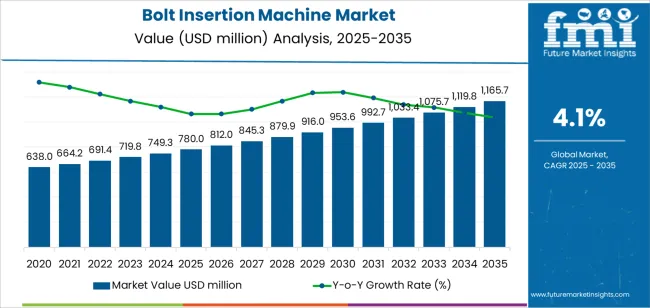
Between 2025 and 2030, the bolt insertion machine market projects expansion from USD 780 million to USD 971 million. This results in a value increase of USD 191 million. The increase represents 49.5% of the total forecast growth for the decade. This development phase will be shaped by increasing adoption of servo-electric technology. Rising demand for precision assembly drives growth. Automated fastening solutions gain market acceptance. Growing emphasis on manufacturing efficiency supports expansion. Enhanced accuracy characteristics attract users. Manufacturing operators expand assembly capabilities. Growing demand for specialized bolt insertion implementations continues. Advanced automation options gain popularity. Industrial offerings across electronics segments increase.
| Metric | Value |
|---|---|
| Estimated Value (2025E) | USD 780 million |
| Forecast Value (2035F) | USD 1,166 million |
| Forecast CAGR (2025-2035) | 4.10% |
From 2030 to 2035, the bolt insertion machine market is forecast to grow from USD 971 million to USD 1,166 million. This adds another USD 195 million. The addition constitutes 50.5% of the overall ten-year expansion. This period is expected to be characterized by expansion of servo-electric systems. Integration of advanced automation solutions continues. Development of specialized bolt insertion implementations occurs. Enhanced precision profiles gain importance. Extended performance capabilities attract users. Growing adoption of fully automated manufacturing will drive demand. Bolt insertion machines with superior accuracy characteristics gains acceptance. Compatibility with digital manufacturing technologies across industrial operations expands.
Between 2020 and 2025, the bolt insertion machine market experienced steady development. Manufacturing automation demand drove market growth. Growing recognition of insertion machines as essential assembly equipment supported expansion. Precision fastening programs across electronics applications gained momentum. Automotive applications showed growth. The bolt insertion machine market developed as operators recognized potential benefits. Bolt insertion solutions provide functional advantages. Assembly efficiency benefits enable convenient manufacturing protocols. Technological advancement in automation systems began development. Accuracy-critical applications emphasize importance of maintaining performance. Consistency in diverse manufacturing environments becomes critical.
Market expansion is supported by increasing demand for assembly automation solutions. Manufacturing efficiency requirements drive growth. Equipment precision management creates demand. Corresponding need for insertion solutions provides superior accuracy benefits. Assembly advantages enable enhanced operational outcomes. Extended compatibility across various electronics applications drives growth. Automotive applications show expansion. Modern operators focus on implementing proven assembly equipment. Precision specialists seek effective fastening support. Minimized assembly complexity appeals to users. Consistent performance throughout complex manufacturing configurations attracts adoption. Diverse industrial environments require reliable solutions. Bolt insertion machines deliver exceptional assembly efficacy against traditional alternatives. Advanced manufacturing integration capabilities support modern protocols. Essential components for contemporary electronics operations gain acceptance.
Growing emphasis on manufacturing precision drives demand for advanced assembly adoption. Bolt insertion machines support large-scale manufacturing requirements. Improved fastening outcomes attract users. Advanced insertion systems gain acceptance. Operator preference for products combines effective assembly support with proven performance. Precision benefits create opportunities for innovative implementations. Rising influence of automation trends contributes to increased demand. Efficiency awareness drives market growth. Bolt insertion machines provide advanced reliability. Seamless manufacturing integration appeals to users. Consistent performance across extended operation periods remains important.
The bolt insertion machine market shows potential for steady growth. Technological advancement continues development. Manufacturing operators across North America seek equipment delivering exceptional insertion quality. Europe shows similar trends. Asia-Pacific markets demonstrate growth potential. Emerging markets seek advanced precision capabilities. Reliable assembly options gain acceptance. Bolt insertion solutions gain prominence beyond traditional equipment. Strategic enablers of manufacturing automation expand applications. Advanced precision functionality grows in importance.
Rising electronics manufacturing adoption in Asia-Pacific amplifies demand. Expanding automation initiatives globally support growth. Manufacturers leverage innovations in assembly engineering. Advanced manufacturing integration gains momentum. Precision management technologies advance rapidly.
Pathways like high-performance implementations show promise for strong margin uplift. Specialized assembly platforms demonstrate potential. Advanced precision solutions target premium manufacturing segments. Geographic expansion captures volume opportunities. Product diversification addresses market needs. Local operator preferences become critical factors. Advanced automation adoption drives regional growth. Regulatory support around precision certification provides structural foundation. Assembly efficacy standards gain importance. Quality protocols strengthen market development.
The bolt insertion machine market is segmented by fastener type, force/capacity, end use, actuation method, and region. By fastener type, the bolt insertion machine market divides into Nuts (PEM/Clinching), Inserts/Studs, Self-Clinching Standoffs, and Other Specialty categories. By force/capacity, it covers ≤30 kN, 31-80 kN, 81-150 kN, and >150 kN segments. By end use, it includes Electronics/Sheet Metal, Automotive Tiering, Appliances/White Goods, and General Fabrication categories. By actuation method, it spans Hydraulic, Pneumatic, Servo-Electric, and Manual/Bench. Regionally, the bolt insertion machine market covers North America, Europe, Asia-Pacific, Latin America, and Middle East & Africa.
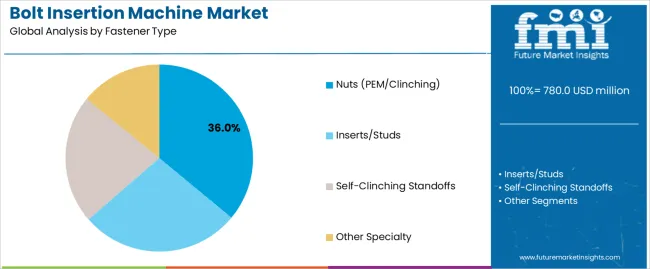
The Nuts (PEM/Clinching) segment projects to account for 36% of the bolt insertion machine market in 2025. This reaffirms its position as the leading fastener type category. Manufacturing operators utilize PEM/Clinching implementations for superior fastening standards. Assembly system integrators prefer these systems when operating across diverse manufacturing platforms. Excellent precision properties attract users. Widespread acceptance ranges from basic insertion operations to critical assembly processing. PEM/Clinching technology's advanced fastening methods address operator requirements for efficient assembly solutions. Complex manufacturing environments benefit from these capabilities.
This fastener type segment forms the foundation of modern manufacturing automation adoption patterns. The implementation offers greatest operational versatility. Established market demand exists across multiple electronics categories. Assembly segments show strong adoption. Operator investments in PEM/Clinching standardization continue. Fastening efficiency improvements strengthen adoption among manufacturing operators. Electronics companies prioritize precision with operational reliability. PEM/Clinching implementations align with functionality preferences. Performance expectations make these systems central components of comprehensive manufacturing automation strategies.
The 31-80 kN capacity applications project to represent 36% of bolt insertion demand in 2025. This underscores their critical role as primary force range for insertion devices. Manufacturing operations use these systems across assembly applications. Production operations benefit from insertion capabilities. Industrial manufacturing applications show strong adoption. Operators prefer this capacity range for exceptional versatility characteristics. Scalable insertion options appeal to users. Ability to handle diverse fastening demands while ensuring consistent insertion performance attracts adoption. Various manufacturing platforms benefit from assembly methods. Essential capacity range for modern industrial operations offers functional advantages. Performance benefits remain important considerations.
The segment gains support from continuous innovation in assembly technologies. Growing availability of specialized implementations enables diverse manufacturing requirements. Enhanced insertion uniformity capabilities expand applications. Extended precision capabilities attract investment. Manufacturing operators invest in advanced insertion systems supporting large-scale industrial integration. Operational development drives growth. Manufacturing automation trends become prevalent. Operator efficiency awareness increases acceptance. Mid-range capacity applications continue representing major implementation markets. Advanced manufacturing utilization strategies gain support. Assembly integration initiatives expand market reach.
Electronics/Sheet Metal applications project to represent 32% of bolt insertion demand in 2025. This demonstrates significance as primary deployment industry for assembly systems. Electronic manufacturing operations benefit from precision advantages. Sheet metal facilities show strong adoption. Electronics/Sheet Metal operators utilize insertion equipment for exceptional accuracy characteristics. Proven reliability in demanding environments attracts users. Ability to maintain consistent assembly performance across diverse operational conditions appeals to operators. The segment's leadership reflects critical nature of precision assembly in electronics operations. Industry commitment to accuracy standards drives adoption.
The electronics/sheet metal sector drives innovation in assembly technology through demanding operational requirements. Stringent precision regulations exist. Operators invest heavily in advanced insertion systems ensuring operational continuity. Quality compliance requirements grow. Increasing emphasis on manufacturing efficiency supports market position. Automation management initiatives expand. Electronics/Sheet Metal applications maintain position as largest end use segment. Technological advancement initiatives continue. Performance optimization across bolt insertion markets gains momentum.
Hydraulic applications project to represent 40% of bolt insertion demand in 2025. This demonstrates significance as primary actuation approach for assembly systems. High-force operations benefit from power advantages. Manufacturing facilities show strong adoption. Hydraulic operators utilize insertion equipment for exceptional force characteristics. Proven reliability in demanding environments attracts users. Ability to maintain consistent assembly performance across various operational conditions appeals to operators. The segment's dominance reflects critical nature of high-force insertion in manufacturing operations. Industry commitment to power standards drives adoption.
The hydraulic sector drives innovation in assembly technology through demanding force requirements. High-force regulations exist. Operators invest heavily in advanced insertion systems ensuring operational power. Force compliance requirements grow. Increasing emphasis on manufacturing efficiency supports market position. Power management initiatives expand. Hydraulic applications maintain position as largest actuation segment. Technological advancement initiatives continue. Performance optimization across bolt insertion markets gains momentum.
The bolt insertion machine market advances steadily due to increasing manufacturing automation requirements driven by efficiency standards. Productivity initiatives support growth. Growing adoption of assembly systems provides superior fastening characteristics. Precision benefits enable enhanced manufacturing outcomes across diverse electronics applications. Automotive applications expand market reach. The bolt insertion machine market faces challenges including high equipment costs compared to traditional alternatives. Complex automation requirements create compliance needs. Specialized operator training requirements grow. Manufacturing programs become more sophisticated. Innovation in servo-electric technology continues influencing product development. Automated solutions drive market expansion patterns.
Growing electronics manufacturing sectors enable market development. Advanced assembly management capabilities expand applications. Industry 4.0 awareness drives equipment manufacturers to produce advanced bolt insertion solutions. Superior precision positioning attracts users. Enhanced reliability profiles gain acceptance. Seamless integration functionalities expand market reach. Advanced assembly systems provide improved operational outcomes. More efficient manufacturing workflows develop. Reliable performance across various electronics applications continues. Operating conditions improve with advanced systems. Developers recognize competitive advantages of assembly solution integration capabilities. Market differentiation opportunities expand. Precision positioning becomes increasingly important.
Modern bolt insertion providers incorporate advanced servo-electric technology. Automation system integration expands capabilities. Sophisticated assembly solutions enhance product appeal. Intelligent insertion features develop rapidly. Value-added solutions for manufacturing customers gain acceptance. These technologies improve assembly efficiency. New market opportunities emerge including standardized performance. Optimized precision enhancement capabilities expand. Enhanced reliability characteristics attract users. Advanced automation integration allows developers supporting comprehensive manufacturing technologies. Market expansion beyond traditional assembly approaches continues.
Growing adoption of specialized fastening solutions enables market development. Advanced fastening management capabilities expand applications. Sheet metal processing awareness drives equipment manufacturers to produce advanced bolt insertion solutions. Superior fastening positioning attracts users. Enhanced durability profiles gain acceptance. Seamless integration functionalities expand market reach. Advanced PEM systems provide improved operational outcomes. More efficient fastening workflows develop. Reliable performance across various sheet metal applications continues. Operating conditions improve with specialized systems. Developers recognize competitive advantages of specialized fastening integration capabilities. Market differentiation opportunities expand. Fastening positioning becomes increasingly important.
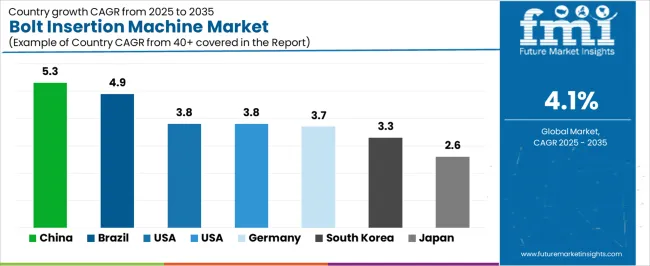
| Country | CAGR (2025-2035) |
|---|---|
| China | 5.3% |
| Brazil | 4.9% |
| United States (USA) | 3.8% |
| United Kingdom (UK) | 3.8% |
| Germany | 3.7% |
| South Korea | 3.3% |
| Japan | 2.6% |
The bolt insertion machine market experiences solid growth globally. China leads at 5.3% CAGR through 2035. Expanding electronics manufacturing drives growth. Growing assembly automation sector supports development. Significant investment in manufacturing technology continues. Brazil follows at 4.9%. Increasing industrial production supports growth. Growing manufacturing modernization patterns develop. Expanding assembly infrastructure drives demand. The United States records 3.8% growth. Expanding electronics capabilities support market development. Manufacturing automation modernization continues. The UK demonstrates 3.8% growth. Advanced assembly technology development occurs. Precision adoption trends drive market expansion. Germany exhibits 3.7% growth. Assembly technology innovation emphasizes development. Industrial advancement continues. South Korea shows 3.3% growth. Quality control initiatives support development. Japan records 2.6% growth supported by technology-focused production patterns.
The report covers in-depth analysis of 40+ countries, the top-performing countries receive highlighting below.
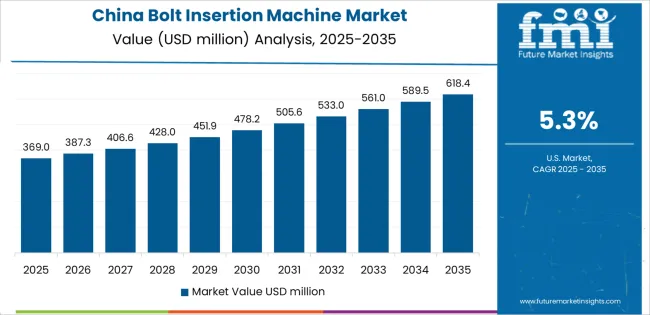
Revenue from bolt insertion machines in China projects exceptional growth with 5.3% CAGR through 2035. Expanding electronics manufacturing capacity drives development. Rapidly growing assembly automation sector receives government initiative support promoting advanced manufacturing development. The country's strong position in manufacturing technology supports growth. Increasing investment in automation infrastructure creates substantial demand for advanced implementations. Major electronics companies establish comprehensive assembly capabilities. Equipment system companies serve domestic manufacturing demand. Expanding export markets drive growth.
China leads global market growth due to its massive electronics manufacturing base and government support for automation. The country benefits from strong consumer electronics industry requiring precision assembly. Major factors include large smartphone and computer production needing automated fastening. Growing automotive electronics manufacturing requiring precision insertion. Strong appliance industry requiring efficient assembly processes. Government policies promoting manufacturing upgrade and automation. Large sheet metal fabrication industry needing precision fastening. Advanced manufacturing technology development programs. Strong supply chain supporting equipment production. Rising focus on high-precision manufacturing capabilities.
Government support for manufacturing modernization initiatives drives demand for advanced assembly systems. Major production regions benefit from development. Manufacturing centers across the country show expansion. Strong electronics technology growth occurs. Expanding network of automation-focused producers supports rapid adoption. Manufacturing operators seek advanced insertion capabilities. Integrated automation technologies gain acceptance.
Revenue from bolt insertion machines in Brazil expands at 4.9% CAGR. The country's growing industrial sector supports development. Expanding manufacturing capacity drives growth. Increasing adoption of assembly technologies continues. Country initiatives promoting industrial modernization create demand. Growing assembly awareness drives requirements for quality-controlled insertion systems. International manufacturing providers establish extensive capabilities. Domestic industrial companies address growing demand for advanced assembly solutions.
Brazil shows strong growth potential driven by industrial expansion and manufacturing modernization. The country experiences significant manufacturing growth supported by domestic demand. Key factors include growing appliance industry requiring automated assembly. Expanding automotive production needing precision fastening solutions. Rising electronics manufacturing sector requiring insertion equipment. Government initiatives to modernize industrial capabilities. Growing adoption of international quality standards. Strategic position for serving Latin American markets. Increasing focus on manufacturing competitiveness. Strong white goods sector requiring precision assembly.
Rising industrial requirements create opportunities for bolt insertion adoption. Metropolitan manufacturing centers show growth. Progressive manufacturers invest in modern assembly facilities. Major industrial regions expand operations. Growing focus on industrial integration drives adoption. Insertion features appeal to manufacturers seeking enhanced operational capabilities. Advanced precision delivery experiences attract investment.
Revenue from bolt insertion machines in the United States expands at 3.8% CAGR. The country's advanced manufacturing technology sector supports development. Strategic focus on assembly solutions continues. Established electronics capabilities drive growth. The US assembly system innovation leadership supports market expansion. Manufacturing technology integration drives demand for specialized implementations in electronics applications. Automotive operations show growth. Advanced performance products expand market reach. Operators invest in comprehensive assembly development serving domestic specialty markets. International quality applications benefit from development.
The United States shows consistent growth driven by manufacturing innovation and precision assembly culture. Strong electronics sector requiring advanced insertion solutions. Key factors include large aerospace industry needing precision fastening equipment. Advanced automotive manufacturing demanding quality assembly systems. Government support for advanced manufacturing initiatives. Focus on manufacturing competitiveness through precision technology. Major defense industry requiring specialized assembly equipment. Strong emphasis on automation and Industry 4.0. Major medical device sector needing precision insertion solutions. Growing focus on high-value manufacturing.
Manufacturing optimization and assembly technology advancement create opportunities for specialized insertion adoption in advanced systems. Electronics services benefit from development. Technology-focused manufacturing operations among leading enterprises gain acceptance. Growing emphasis on advanced assembly delivery drives adoption. Insertion features support quality implementations with enhanced technology profiles. Integrated assembly management throughout the country's manufacturing technology sector expands market reach.
Revenue from bolt insertion machines in the UK expands at 3.8% CAGR. The country's precision engineering heritage supports development. Strategic focus on manufacturing solutions continues. Established electronics capabilities drive growth. The UK's assembly system innovation leadership supports market expansion. Engineering technology integration drives demand for specialized implementations in manufacturing applications. Automotive operations show growth. Advanced quality products expand market reach. Operators invest in comprehensive insertion development serving domestic precision markets. International applications benefit from development.
The UK shows consistent growth driven by precision engineering heritage and manufacturing excellence. Strong aerospace sector requiring precision assembly solutions. Key factors include advanced electronic systems programs requiring high-precision insertion. Growing manufacturing sector needing specialized assembly capabilities. Strong emphasis on manufacturing excellence driving quality requirements. Focus on high-value manufacturing through precision technology. Advanced automotive electronics industry requiring precision assembly. Strong position in industrial equipment manufacturing. Growing emphasis on manufacturing innovation. Strong technical education supporting skilled operators.
Engineering optimization and precision technology advancement create opportunities for specialized assembly adoption in advanced systems. Manufacturing services benefit from development. Technology-focused engineering operations among leading enterprises gain acceptance. Growing emphasis on advanced insertion delivery drives adoption. Assembly features support quality implementations with enhanced technology profiles. Integrated precision management throughout the country's engineering technology sector expands market reach.
Revenue from bolt insertion machines in Germany expands at 3.7% CAGR. The country's engineering heritage supports development. Strong emphasis on assembly technology continues. Robust demand for advanced insertion systems exists in manufacturing applications. Electronics applications drive growth. The nation's mature manufacturing sector supports development. Technology-focused operations drive sophisticated implementations throughout the assembly industry. Leading manufacturers invest extensively in technology development. Advanced insertion methods serve domestic markets. International markets benefit from German expertise.
Germany maintains its position as Europe's precision engineering leader with Industry 4.0 initiatives driving automation adoption. The country's advanced manufacturing culture supports intelligent assembly systems. Growth drivers include world-class automotive industry requiring precision assembly solutions. Advanced electronics manufacturing sector demanding quality insertion equipment. Strong appliance industry needing specialized assembly systems. Excellent engineering education producing precision manufacturing expertise. High quality standards encouraging sophisticated equipment. Advanced manufacturing processes requiring extreme precision. Well-developed industrial infrastructure supporting precision equipment. Strong tradition of engineering excellence in manufacturing.
Rising demand for high-performance precision technologies creates requirements for sophisticated solutions. Exceptional assembly capabilities appeal to quality-conscious manufacturers. Enhanced manufacturing experiences gain acceptance. Advanced insertion methods attract investment. Strong engineering tradition supports growth. Growing investment in precision technologies drives adoption. Quality platforms with advanced development methods appeal to users. Enhanced precision profiles across manufacturing operations expand in major industrial regions.
Revenue from bolt insertion machines in South Korea grows at 3.3% CAGR. The country's technology integration initiatives drive development. Expanding electronics sector supports growth. Strategic focus on assembly development continues. South Korea's advanced manufacturing capabilities support market expansion. Commitment to industrial modernization drives investment in specialized technologies. Major manufacturing regions benefit from development. Industry leaders establish comprehensive technology integration systems. Domestic electronics operations benefit from advanced assembly applications.
South Korea exhibits growth driven by advanced manufacturing culture and electronics industry development. Key drivers include major electronics companies like Samsung and LG requiring precision assembly solutions. Strong semiconductor industry needing specialized insertion equipment. Government support for advanced manufacturing technologies. Growing focus on precision manufacturing in electronics sector. High technology adoption culture in industrial applications. Rising emphasis on quality control in manufacturing processes. Advanced manufacturing automation capabilities. Strong emphasis on export competitiveness through precision technology. Growing automotive electronics sector requiring precision assembly.
Innovations in assembly platforms create demand for advanced implementations. Technology integration capabilities attract users. Exceptional precision properties appeal to progressive manufacturers. Enhanced technology differentiation gains acceptance. Operational appeal drives adoption. Growing electronics adoption supports market development. Increasing focus on assembly innovation drives advanced platform adoption. Integrated insertion delivery gains acceptance. Manufacturing optimization across electronics enterprises throughout the country expands market reach.
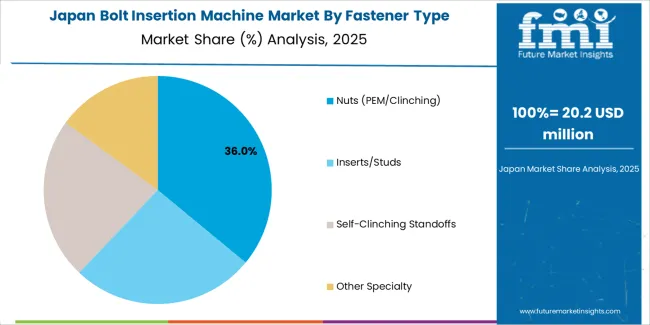
Revenue from bolt insertion machines in Japan expands at 2.6% CAGR. The country's assembly system excellence initiatives support development. Growing precision technology sector continues expansion. Strategic emphasis on advanced manufacturing development drives market growth. Japan's advanced quality control capabilities support demand. Integrated assembly systems drive demand for high-quality platforms in manufacturing operations. Electronics applications grow. Advanced technology applications expand market reach. Leading manufacturers invest in specialized capabilities. Technology-focused manufacturing requirements gain attention. Precision industries demand sophisticated solutions.
Japan shows steady growth supported by quality-focused manufacturing culture and advanced technology development. Growth factors include highly sophisticated electronics industry with companies like Panasonic and Sony. Strong emphasis on quality control and continuous improvement (kaizen). Advanced manufacturing processes requiring extreme precision. Strong machine tool manufacturing capabilities producing insertion equipment. Focus on precision manufacturing for competitive advantage. High technology adoption in manufacturing processes. Strong materials science and precision engineering capabilities. Advanced automation in manufacturing requiring precision assembly. Growing focus on sustainable manufacturing through precision technology.
Quality control advancement creates requirements for specialized solutions. Superior quality integration appeals to users. Exceptional precision capabilities attract investment. Advanced performance features gain acceptance among quality-conscious manufacturing operations. Manufacturing operators seek sophisticated systems. Strong position in precision technology innovation supports adoption. Advanced systems with validated assembly characteristics gain acceptance. Quality integration capabilities throughout the country's manufacturing technology sector expand.
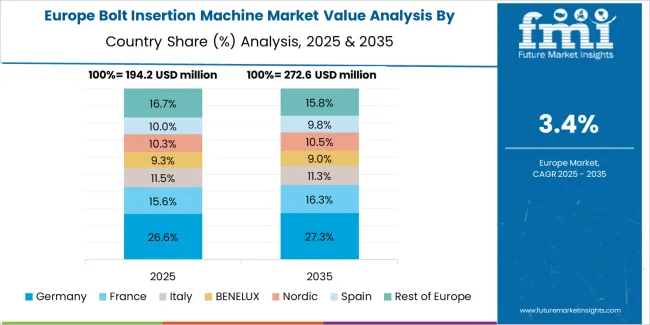
The bolt insertion machine market in Europe projects growth from USD 234 million in 2025 to USD 350 million by 2035. This registers CAGR of 4.1% over the forecast period. Germany expects to maintain leadership position with 34.2% market share in 2025. This declines slightly to 33.9% by 2035. Support comes from strong engineering culture. Sophisticated assembly manufacturing capabilities continue. Comprehensive industrial sector serves diverse applications across Europe.
United Kingdom follows with 24.8% share in 2025. This projects to reach 25% by 2035. Robust demand for advanced assembly technologies in manufacturing applications drives growth. Precision modernization programs support development. Insertion markets benefit from established industrial infrastructure. Technology integration expertise continues. France holds 17.9% share in 2025. This expects to reach 18.1% by 2035. Strong precision technology sector supports growth. Growing manufacturing activities drive development. Italy commands 12.4% share in 2025. This projects to reach 12.5% by 2035. Spain accounts for 7.3% in 2025. This expects to reach 7.4% by 2035. Rest of Europe region anticipates maintaining momentum. Collective share moves from 3.4% to 3.1% by 2035. Increasing assembly modernization in Eastern Europe drives development. Growing technology penetration in Nordic countries implementing advanced manufacturing programs supports expansion.
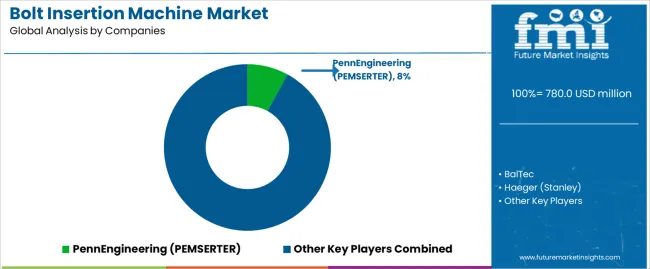
The bolt insertion machine market demonstrates moderate competition among established fastening equipment manufacturers, specialized assembly automation providers, and integrated manufacturing solution companies. Companies invest significantly in servo-electric technology development, automation optimization, precision engineering advancement, and comprehensive service capabilities to deliver reliable, accurate, and cost-effective bolt insertion solutions. Innovation in hydraulic systems, digital controls, advanced fastening methods, and IoT connectivity remains central to strengthening market position and competitive advantage across global markets.
PennEngineering (PEMSERTER) leads the bolt insertion machine market with an 8% market share, offering comprehensive bolt insertion solutions, including quality PEM fastening platforms and advanced automation systems, with particular focus on electronics and automotive applications. The company's strength lies in PEM fastening innovation, providing integrated solutions that combine traditional fastening expertise with modern automation technology. BalTec provides specialized precision assembly capabilities with strong emphasis on advanced bolt insertion implementations and innovative fastening solutions, particularly serving electronics and appliance markets. Haeger (Stanley) delivers comprehensive assembly services with focus on integrated platforms and large-scale manufacturing applications, combining insertion technology with complete production solutions.
Orbitform specializes in assembly automation and precision insertion implementations for manufacturing environments, expanding market reach through comprehensive forming and fastening solutions. TOX Pressotechnik focuses on premium assembly integration and innovative technology solutions for industrial markets. BalTec-AG offers advanced insertion platforms with emphasis on high-precision and specialized applications, serving both electronics and automotive sectors. The competitive environment also includes significant players like Promess, Gage Bilt, SPIROL, and Rivnut (Bollhoff), each focusing on specific market segments and technological specializations in fastening and assembly equipment.
The competitive landscape reflects ongoing technological advancement as companies develop more sophisticated servo-electric systems, automated handling capabilities, and integrated quality control systems. Companies focus on developing comprehensive solutions that combine bolt insertion technology with digital monitoring systems, predictive maintenance capabilities, and advanced control technologies to differentiate offerings and capture higher-value market segments. Strategic partnerships between equipment manufacturers and manufacturing operators drive innovation and market expansion, while increasing emphasis on operator training and technical support creates opportunities for companies to develop comprehensive service ecosystems around their equipment platforms.
| Item | Value |
|---|---|
| Quantitative Units | USD 780 million |
| Fastener Type | Nuts (PEM/Clinching); Inserts/Studs; Self-Clinching Standoffs; Other Specialty |
| Force/Capacity | ≤30 kN; 31-80 kN; 81-150 kN; >150 kN |
| End Use | Electronics/Sheet Metal; Automotive Tiering; Appliances/White Goods; General Fabrication |
| Actuation Method | Hydraulic; Pneumatic; Servo-Electric; Manual/Bench |
| Regions Covered | North America; Europe; Asia-Pacific; Latin America; Middle East & Africa |
| Countries Covered | United States; China; Germany; United Kingdom; Japan; South Korea; Brazil; and 40+ additional countries |
| Key Companies Profiled | PennEngineering (PEMSERTER); BalTec; Haeger (Stanley); Orbitform; TOX Pressotechnik; BalTec-AG |
| Additional Attributes | Dollar sales by fastener type and end use category; regional demand trends; competitive landscape; technological advancements in precision assembly; servo-electric development; automation innovation; manufacturing integration protocols |
The global bolt insertion machine market is estimated to be valued at USD 780.0 million in 2025.
The market size for the bolt insertion machine market is projected to reach USD 1,165.7 million by 2035.
The bolt insertion machine market is expected to grow at a 4.1% CAGR between 2025 and 2035.
The key product types in bolt insertion machine market are nuts (pem/clinching), inserts/studs, self-clinching standoffs and other specialty.
In terms of force/capacity, 31-80 kn segment to command 36.0% share in the bolt insertion machine market in 2025.






Full Research Suite comprises of:
Market outlook & trends analysis
Interviews & case studies
Strategic recommendations
Vendor profiles & capabilities analysis
5-year forecasts
8 regions and 60+ country-level data splits
Market segment data splits
12 months of continuous data updates
DELIVERED AS:
PDF EXCEL ONLINE
Fastener Insertion Machine Market Analysis - Size, Share, and Forecast Outlook 2025 to 2035
Machine Glazed Paper Market Size and Share Forecast Outlook 2025 to 2035
Machine Glazed Kraft Paper Market Forecast and Outlook 2025 to 2035
Machine Condition Monitoring Market Size and Share Forecast Outlook 2025 to 2035
Machine Glazed Paper Industry Analysis in Asia Pacific Forecast Outlook 2025 to 2035
Machine Vision Camera Market Size and Share Forecast Outlook 2025 to 2035
Machine Tool Oils Market Size and Share Forecast Outlook 2025 to 2035
Machine Vision System And Services Market Size and Share Forecast Outlook 2025 to 2035
Machine Glazed Paper Industry Analysis in Western Europe Size and Share Forecast Outlook 2025 to 2035
Machine Glazed Paper Industry Analysis in Korea Size and Share Forecast Outlook 2025 to 2035
Machine Glazed Paper Industry Analysis in Japan Size and Share Forecast Outlook 2025 to 2035
Machine Tool Cooling System Market Analysis - Size, Share, and Forecast Outlook 2025 to 2035
Machine Tool Touch Probe Market Analysis - Size, Growth, and Forecast 2025 to 2035
Machine Mount Market Analysis - Size & Industry Trends 2025 to 2035
Machine Control System Market Growth – Trends & Forecast 2025 to 2035
Machine Automation Controller Market Growth – Trends & Forecast 2025 to 2035
Machine-to-Machine (M2M) Connections Market – IoT & Smart Devices 2025 to 2035
Machine Safety Market Analysis by Component, Industry, and Region Through 2035
Key Players & Market Share in Machine Glazed Paper Industry
Machine Vision Market Insights – Growth & Forecast 2024-2034

Thank you!
You will receive an email from our Business Development Manager. Please be sure to check your SPAM/JUNK folder too.
Chat With
MaRIA